Didn’t sleep well last night, had to drop a kid off at school at 7am, car broke in the bus lane at school (fortunately I got moving before the buses arrived), $700 repair fee at the dealer, forgot to get my husband to move the heavy birdbath so I could grout it, my dogs are wreaking havoc on my garden, and aphids are wreaking havoc on my plants. BUT.. other than that it’s a fine day.
Look what I discovered this morning! Know what these are? I just learned what they are at a lecture by a local entomologist last night, and lo and behold I found some in my garden the very next day. Life works in funny ways, doesn’t it?
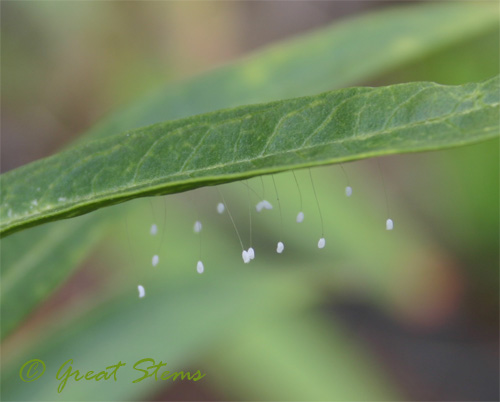 These are the eggs of green lacewings. As larvae, they are voracious aphid eaters. Yay, another ally in the garden! I need them because the aphids are worse than ever. I seem to have least three species now — I’ll call them green, yellow, and beige. The green I’m sure are corn leaf aphids. I have got to get out and tackle them TODAY. My veggies, my milkweed, and now my firebush plant are all having an aphid problem. The little pests took advantage of my time away from the garden during the rainy week and bred like rabbits. I’m starting to think that it’s the other way around, and rabbits breed like aphids. Today I’m seeing wings on some. Gah, more colonization!
These are the eggs of green lacewings. As larvae, they are voracious aphid eaters. Yay, another ally in the garden! I need them because the aphids are worse than ever. I seem to have least three species now — I’ll call them green, yellow, and beige. The green I’m sure are corn leaf aphids. I have got to get out and tackle them TODAY. My veggies, my milkweed, and now my firebush plant are all having an aphid problem. The little pests took advantage of my time away from the garden during the rainy week and bred like rabbits. I’m starting to think that it’s the other way around, and rabbits breed like aphids. Today I’m seeing wings on some. Gah, more colonization!
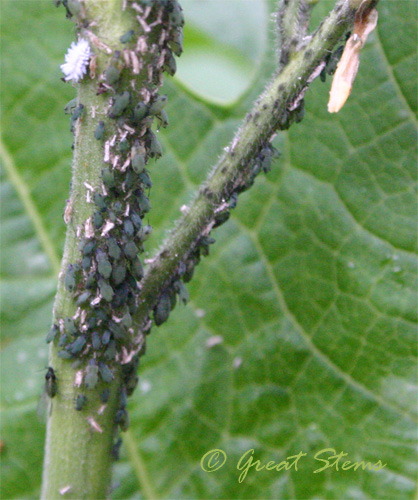
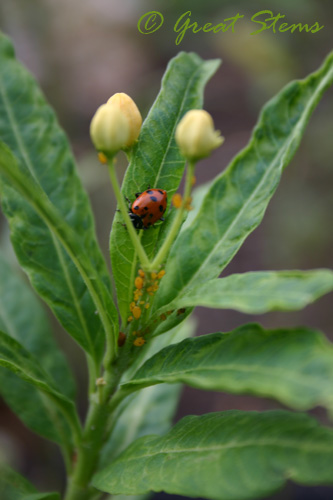 So I’ve got new lacewings arriving soon, and of course I’ve got ladybugs. More spiders are arriving, as are earthworms. The bees are getting plentiful, and I don’t even have to do the veggie porn thing to pollinate my plants anymore. I truly love the way nature just naturally (ha) balances its ecosystems. Got organic wastes? Happy earthworms move in. Got flowers? Let’s pollinate. Overpopulation of something? Here come the predators. And here come the predators to eat the other predators. Oh look, birdie treats. And then snakes. And hawks. Whee, life is grand.
So I’ve got new lacewings arriving soon, and of course I’ve got ladybugs. More spiders are arriving, as are earthworms. The bees are getting plentiful, and I don’t even have to do the veggie porn thing to pollinate my plants anymore. I truly love the way nature just naturally (ha) balances its ecosystems. Got organic wastes? Happy earthworms move in. Got flowers? Let’s pollinate. Overpopulation of something? Here come the predators. And here come the predators to eat the other predators. Oh look, birdie treats. And then snakes. And hawks. Whee, life is grand.
I call these my bees because I’m so fond of them, but of course they are wild. They get a little drunk-like in their flying when they are heavily loaded with pollen — it’s fun to watch. The pumpkin flowers were all abuzz this morning with bees about, and as I took pictures, I realized that there was some hostility going on. It seems at least one other colony has found our garden, and apparently different bee colonies don’t play nicely with others.
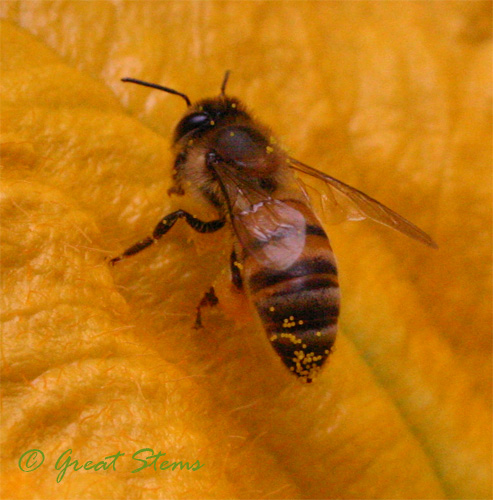
Know what else I learned from the entomologist? Feral honeybees in Texas and other states of the Southwest have all been Africanized in some way. Only beekeepers are able to keep sound European colonies because of their control of the queens.
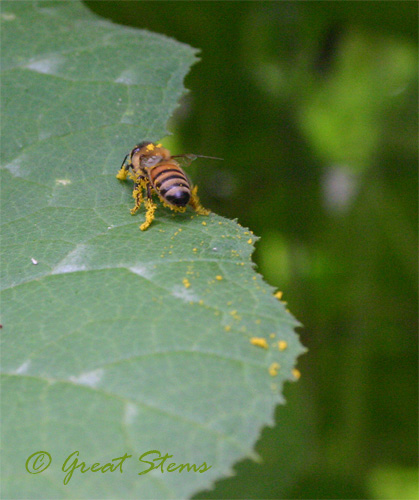
FYI, in case I’ve scared anyone, bees in your garden are not a threat — don’t rush out and kill them, please! They are not in stinging mode when they are out pollinating — that’s quite counter-productive to their hive’s needs. Africanized honeybees, or any bees really, are a danger only when you threaten their hive (allergies aside), and apparently they’ll give a warning by buzzing around your head or actually bonking you on the head, believe it or not. If you find yourself near a wild hive, RUN — don’t walk away. Like fire ants, the Africanized honeybees give word to others in their colony by pheromones, and you need to put immediate distance (at least 200 yards) between you and the hive. Other than their defensiveness in protecting their hive, Africanized bees are not really any different from other bees. And actually there have been positive changes in their aggressiveness, too, depending on factors of colony age and breeding with European bees. It’s all good. No worries. As with anything, just be aware, not necessarily beware. Ooh, I like that.
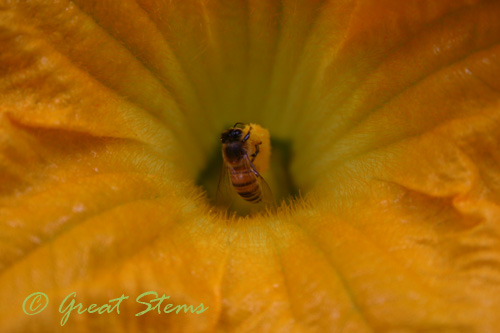
By the way, have you hugged a beekeeper today? Not only do they raise pollinators and help with honey production, they are helping tremendously by keeping domestic European bee colonies intact, as well as helping breed gentler stocks of Africanized bees by culling out aggressive queens. Hug!
Thanks to my bees, I have several pumpkins growing. One is approaching the size of a soccer ball now (it’s been a week since I discovered female buds in bloom). Another is growing in the dead tree. And more are scattered here and there — finding them is like going on an Easter Egg hunt. There’s one! There’s another one! Again, how I love nature.
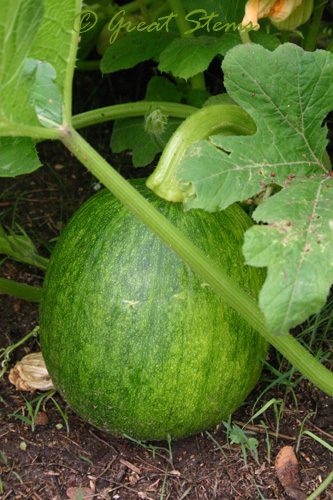
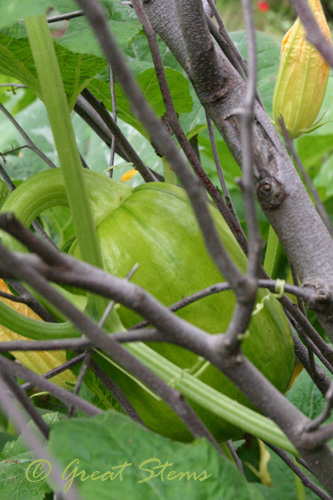 With the rain this week, the yard is a big mudfest for the dogs, and they took advantage of it — digging where they shouldn’t, trampling through the butterfly garden, and taking turns leaping over the pumpkin vines. I’m out there yelling, “This is not your playground!” And then I realized my neighbor must think I’m nuts, because of course it IS their playground. If I can manage it, I’ll try to get a picture of the husky leaping in full gallop over the massive pumpkin plants (in between my yelling at him, of course). It really is a sight to behold.
With the rain this week, the yard is a big mudfest for the dogs, and they took advantage of it — digging where they shouldn’t, trampling through the butterfly garden, and taking turns leaping over the pumpkin vines. I’m out there yelling, “This is not your playground!” And then I realized my neighbor must think I’m nuts, because of course it IS their playground. If I can manage it, I’ll try to get a picture of the husky leaping in full gallop over the massive pumpkin plants (in between my yelling at him, of course). It really is a sight to behold.
Ah…such a relaxing day…haha. Doesn’t it seem like things happen all at once?
I love the pumpkin. I had some come up in the compost. Thought it was safe to put them out in the yard, since the deer didn’t eat the actual pumpkin. Wrong! So, I’ll just enjoy watching yours.
Thanks.
Oh man, what a hectic and crazy day for you! And $700 in car repairs would be enough to make me cry! You seem to handle it with grace and elegance–traits that I need to emulate. I love how you get up close and personal with those bugs you see in the garden. I’ve never seen lacewings eggs and it was pretty cool to see them macro style! Thanks for sharing and I’m glad you’ve got some great aphid-eaters happening in your gardens, too! There’s hope! I have loved our bees this year. In fact, I think they are the cause for some great blooms! I hope your day gets better!
Linda, I hope I don’t regret tossing all my cantaloupe, seeds and all, into the compost. Anything that does come up will get plucked. Too late to worry about it now, I guess!
Bugs do fascinate me, I admit. I plan to take more pictures of our native bees, but it’s so easy to get distracted by the honeybees, especially when they dominate the scene. But in truth the native bees found us first. Hopefully I’ll have plenty of flowers to go around! 😉
Meredith, What an excellent post! I loved reading every bit of it…even the parts with the aphids. I can tolerate all manner of bugs, worms, etc, but those soft bodies bugs give me the creeps. I am glad that help is on the way! I sometimes rely on the trusty hose…but then we haven’t had water rationing. Reading about the bees and finding out about africanized bees and our native populations was fascinating. I’ve wondered what was going on in that arena. Wonderful photos of the bees. gail, clay and limestone
Sorry about the birdbath/bus/$700/lack of sleep/et al, but ooooh! Lucky you! Just look at those cool insects! I adore the photo of the green lacewing eggs.
Fantastic that you got the lacewing eggs – marvelous shots. I do so love bug pictures!
I just don’t know who to pick in the Blotanical Best Texas Blog category – all you finalist bloggers are fantastic!
Meredith, Great images! Killer macro. Best of luck in your aphid war. Hope your allies keep up their battle as it looks like the aphids picked up some white fly help. Come on lacewings.
Scott
aaaaaahhhh! Maybe I don’t want a macro lens after all!!! I am totally grossed out yet fascinated by those bugs at the same time.
The pumpkins look beautiful!!!
That photo of the bee leaving a trail of pollen behind is so incredibly hilarious! You should enter that photo in a contest Meredith!
Sorry about the car. Car repairs suck. I hate spending that kind of money without something to show for it!
Wendy, my favorite thing about that bee photo is that he’s wearing the cutest bright yellow socks!
I’ve been buzzed and bonked on the head by the bees at my stock tank, Meredith. Not a fun experience, but no stings so far. I’m a little freaked out by the idea that all wild bees have been “Africanized,” but I will remain calm. Nice to know about the lacewing eggs. I see them all over my garden, but I never knew what they were.
Hmmm. Hopefully they were still fighting more among themselves and not really warning you in particular. And I still think that most hives are going to behave as normal bees would. I think the best thing is to just keep a distance if you see a hive. One more tip from the entomologist is to avoid the colors red and black (typical of lawnmowers). See, another reason people should reduce their lawns! 🙂
Great insect shots and as always very informative. I’ve never seen our bees with as much pollen on their legs as you captured in your shot. In fact, I’ve never seen a photo like that in any bee book or bee magazine either. You should submit it to Bee Culture magazine. I just love the little pollen trail she is leaving behind her. It just screams for a caption like, “Wipe your feet!”
I’ve never seen the lacewings eggs before. I would have gone bonkers trying to figure out what they were. And the overburdened bee – great catch. Her Queen must be a real slave driver 🙂
absolutely awesome pictures!
sounds like you’ve got a pretty good plan using nature to balance nature. sorry to hear about the aphids. an employee at Home Depot in Hutto told me today that they have live nematodes… you might want to check that out.
Those lacewing eggs are amazing! Thanks for sharing that photo, I’ve never seen anything like that before!
First off I am so, so sorry about your car breaking down and that lousy bill. sheesh. Secondly, those were some fantastic bee shots! I don’t even think I have seen them so clearly with my own eyes as you have captured them with your camera. Nice work. Viva la bees!